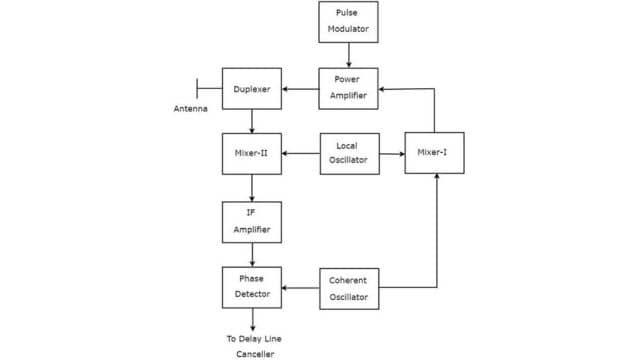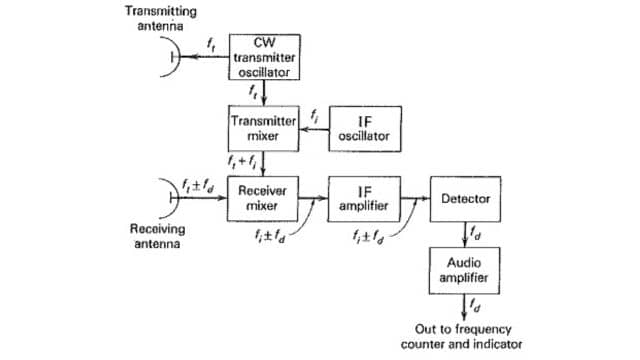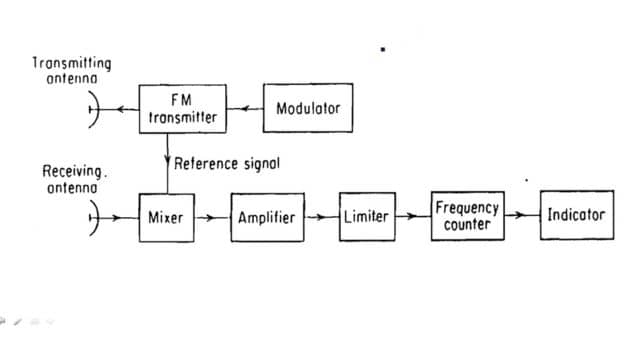
Table of Contents
Radar
RADAR stands for Radio Detection and Ranging System. Radar detection system uses radio waves to determine objects’ range, angle, or velocity. It can detect aircraft, ships, spacecraft, guided missiles, and motor vehicles.
Types of Radar
Radars can be classified into the following two types based on the type of signal with which the radar can be operated:
- Pulse Radar
- Continuous Wave Radar
1. Pulse Radar
The Radar, which operates with a pulse signal is called the Pulse Radar. Pulse Radar can be classified into the following two types based on the type of target it detects.
- (i) Basic Pulse Radar
- (ii) Moving Target Indicator Radar
(i) Basic Pulse Radar
The Radar, which operates with a pulse signal for detecting stationary targets is called the Basic Pulse Radar or, Pulse Radar. It uses a single antenna for both transmitting and receiving signals with the help of a Duplexer.

Pulse Modulator: It produces a pulse-modulated signal and it is applied to the Transmitter.
Transmitter: It transmits the pulse-modulated signal, which is a train of repetitive pulses.
Duplexer: It is a microwave switch, that connects the antenna to both the Transmitter section and receiver section alternately. The antenna transmits the pulse-modulated signal when the duplexer connects the antenna to the transmitter. Similarly, the signal which is received by the antenna will be given to the Low Noise RF Amplifier, when the duplexer connects the Antenna to Low Noise RF Amplifier.
Low Noise RF Amplifier: It amplifies the weak RF signal, which is received by the Antenna. The output of this amplifier is connected to the Mixer.
Local Oscillator: It produces a signal having stable frequency. The output of the local oscillator is connected to the Mixer.
Mixer: We know that a mixer can produce both the sum and difference of the frequency that is applied to it. Among these, the difference of the frequencies will be of intermediate frequency (IF) type.
IF Amplifier: IF amplifier amplifies the intermediate frequency (IF) signal. The IF Amplifier allows only the intermediate frequency, which is obtained from mixer and amplifies it. It improves the Signal to Noise Ratio at output.
Detector: It demodulates the signal, which is obtained at the output of the IF Amplifier.
Video Amplifier: As the name suggests, it amplifies the video signal, which is obtained at the output of the detector.
Display: It displays the amplified video signal on a CRT screen.
(ii) Moving Target Indicator Radar
The Radar, which operates with a pulse signal for detecting non-stationary targets, is called Moving Target Indicator Radar or simply MTI Radar. It uses a single antenna for both the transmission and reception of signals with the help of a Duplexer. MTI Radar uses the principles of the Doppler Effect to distinguish non-stationary targets from stationary objects.

Pulse Modulator: It produces a pulse-modulated signal and it is applied to the Power Amplifier.
Power Amplifier: It amplifies the power level of the Pulse modulated signal.
Local Oscillator: It produces a signal having stable frequency. Hence, it is called a stable local oscillator. The output of the Local oscillator is applied to both Mixer-1 and Mixer-2.
Coherent Oscillator: It produces a signal having an intermediate frequency, fc. The signal is used as the reference signal. The output of the Coherent Oscillator is applied to both Mixer-1 and Phase Detector.
Mixer-1: The Mixer can produce either the sum or difference of the frequencies that are applied to it. The signals having frequencies of fl and fc are applied to Mixer-1. Here, the Mixer-1 is used for producing the output, which has the frequency fl+fc.
Duplexer: It is a microwave switch, which connects the antenna to either the transmitter section or the receiver section based on the requirement. The antenna transmits the signal having frequency fl+fc when the duplexer connects the antenna to Power Amplifier. Similarly, the Antenna receives the signal having a frequency of fl+fc+fd, when the duplexer connects the antenna to the Mixer-2.
Mixer-2: A Mixer can produce either the sum or difference of the frequencies that are applied to it. The signals having frequencies fl+fc+fd and fl are applied to Mixer-2. Here, the Mixer-2 is used for producing the output, which has the frequency fc+fd.
IF Amplifier: IF Amplifier amplifies the intermediate frequency (IF) signal. The IF amplifier amplifies the signal having frequency fc+fd. This amplified signal is applied as an input to the Phase Detector.
Phase Detector: It is used to produce the output signal having frequency fd from the applied two input signals, which have the same frequencies of fc+fd and fc. The detector compares the IF signal with the reference signal from the COHO oscillator. This phase difference is the Doppler frequency. Phase detector gives the output both for fix and moving targets. The phase difference is constant for all fixed targets but varies for moving targets. The output of the phase detector can be connected to the delay line canceller.
Delay Line: The delay line subtracts the output for each pulse from the preceding one by dealing with earlier output by a time equal to pulse interval (1/PRF).
2. Continuous Wave RADAR
CW Doppler Radars give accurate measurements of relative velocities. Hence, these are used mostly, where the velocity information is more important than the actual range. In a CW RADAR electromagnetic radiation is emitted instead of pulses. It is used for speed measurement.

CW Transmitter: It produces an analog signal having a frequency of ft. The output of the CW Transmitter is connected to both the transmitting antenna and Transmitter mixer-1.
Local Oscillator: It produces a signal having a frequency of fi. The output of the Local Oscillator is connected to Transmitted Mixer-1.
Mixer-1: The Mixer can produce both the sum and difference of the frequencies that are applied to it. The signals having frequencies of ft and fi are applied to mixer-1. So, the Mixer-1 will produce the output having frequencies ft+fi or ft-fi.
Receiver Mixer-2: A Mixer can produce both the sum and difference of the frequencies that are applied to it. The signals having frequencies of fl+fi and fo+fd are applied to the receiver Mixer-2. So, the Mixer-2 will produce the output with frequencies of fi+fd.
IF Amplifier: IF Amplifier amplifies the intermediate frequency (IF) signal. The IF amplifier allows only the intermediate frequency, fi+fd, and amplifies it.
Detector: It detects the signal, which has Doppler frequency, fd.
Doppler Amplifier: As the name suggests, the Doppler amplifier amplifies the signal with Doppler frequency, fd.
Indicator: It indicates the information related to relative velocity and whether the target is inbound or outbound.
Frequency Modulated CW Radar
Simple continuous wave radar devices without frequency modulation have the disadvantage that they cannot determine target range because they lack the timing mark necessary to allow the system to time accurately the transmit and receive cycle and convert this into range. A very important type of FMCW radar pulse is the linear FM sweep.
The transmitted signal hits the target and reflects to the receive antenna. The frequency difference between the received signal and the transmitted signals increases with delay, and the delay is linearly proportional to the range, that is the distance of the target from the radar. The echo from the target is then mixed with the transmitted signal and down-converted to produce a beat signal which is linearly proportional to the target range after demodulation.

Doppler Radar
A Doppler radar is a special form of radar that employs the use of the Doppler Effect to produce velocity data about an object at a given distance. This is achieved by sending electromagnetic signals towards a target and then analyzing how the object’s motion has affected the frequency of the returned signal. This variation can give extremely accurate measurements of the radial components of the target’s velocity on the radar. Doppler radars have applications in different industries including aviation, meteorology, healthcare, and many others.
Weather Radar
Weather radars are radar systems that are used for weather sensing and detection. This radar uses radio waves along with horizontal or circular polarization. The frequency selection of weather radars depends on a performance compromise between precipitation reflection and attenuation as a result of atmospheric water vapor. Some weather radars are designed to use Doppler shifts to measure the speed of wind and dual- polarization to identify precipitation types.
Mapping Radar
Mapping radars are used to scan a large geographical region for geography and remote sensing applications. Because of their use of synthetic aperture radar, they are limited to relatively static objects. Some specific radar systems can sense humans behind walls thanks to the reflective characteristics of humans that are more diverse than the ones found in construction materials.
Navigational Radars
Navigational radars are generally the same as search radars. However, these shorter wavelengths are capable of reflecting from the earth and stones. They are most common on commercial ships and other long-distance commercial aircraft. Various navigational radars include marine radars commonly mounted on ships for collision avoidance and navigational purposes.
Advantages of Radar
The following are the advantages of radar are:
- The radar can see through the medium, which consists of fog, snow, rain, darkness, clouds, etc.
- Radar signals can penetrate and see through insulators.
- It can distinguish fixed as well as moving target types.
Disadvantages of Radar
Following are the disadvantages of radar are:
- It can not distinguish and resolve multiple targets very close to our eye.
- It can not recognize the color of the targets.
- It can not see targets in the water or too deep.
Frequently Asked Questions(FAQs)
What are the main types of Radar?
These are the main types of Radar are:
1. Pulse Radar
2. Continuous wave Radar
3. Doppler Radar
4. Weather RadarWhat are the advantages of using Radar?
These are the basic advantages of radar are:
1. Capable of detecting objects at long distances
2. properly work in weather conditions, including rain, fog
3. It provides a wide coverage area making it suitable for applications.What are the main disadvantages of radar?
These are the main disadvantages of radar are:
1. It can not recognize the color of the targets.
2. It can not see the targets in the water and is too deep.What is MTI?
MTI stands for Moving Target Indicator, which operates with a pulse signal for detecting non-stationary targets is called MTI.












Leave a Reply